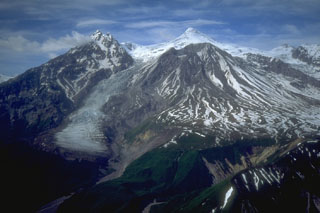Report on Spurr (United States) — 27 June-3 July 2012
Smithsonian Institution / US Geological Survey
Weekly Volcanic Activity Report, 27 June-3 July 2012
Managing Editor: Sally Sennert.
Please cite this report as:
Global Volcanism Program, 2012. Report on Spurr (United States) (Sennert, S, ed.). Weekly Volcanic Activity Report, 27 June-3 July 2012. Smithsonian Institution and US Geological Survey.
Spurr
United States
61.299°N, 152.251°W; summit elev. 3374 m
All times are local (unless otherwise noted)
AVO reported that a minor increase in seismicity at Spurr was detected at about 0500 on 25 June, lasted about 45 minutes, and was characterized by several discrete M1earthquakes. The signals recorded were consistent with seismic energy generated by an energetic flow of water, possibly indicating a glacial outburst flood on the lower S flank. The next day seismic levels had declined to near background and no additional flowage signals were observed.
Geological Summary. Mount Spurr is the closest volcano to Anchorage, Alaska (130 km W) and just NE of Chakachamna Lake. The summit is a large lava dome at the center of a roughly 5-km-wide amphitheater open to the south formed by a late-Pleistocene or early Holocene debris avalanche and associated pyroclastic flows that destroyed an older edifice. The debris avalanche traveled more than 25 km SE, and the resulting deposit contains blocks as large as 100 m in diameter. Several ice-carved post-collapse cones or lava domes are present. The youngest vent, Crater Peak, formed at the southern end of the amphitheater and has been the source of about 40 identified Holocene tephra layers. Eruptions from Crater Peak in 1953 and 1992 deposited ash in Anchorage.
Source: US Geological Survey Alaska Volcano Observatory (AVO)

